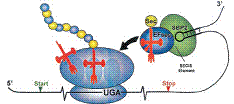Biochemistry, Department of

Vadim Gladyshev Publications
Document Type
Article
Date of this Version
December 2005
Abstract
Selenocysteine (Sec) is inserted into selenoproteins co-translationally with the help of various cis- and trans-acting factors. The specific mechanisms of Sec biosynthesis and insertion into protein in eukaryotic cells, however, are not known. Two proteins, SECp43 and the soluble liver antigen (SLA), were previously reported to interact with tRNA [Ser]Sec, but their functions remained elusive. Herein, we report that knockdown of SECp43 in NIH3T3 or TCMK-1 cells using RNA interference technology resulted in a reduction in the level of methylation at the 2’-hydroxylribosyl moiety in the wobble position (Um34) of Sec tRNA [Ser]Sec, and consequently reduced glutathione peroxidase 1 expression. Double knockdown of SECp43 and SLA resulted in decreased selenoprotein expression. SECp43 formed a complex with Sec tRNA [Ser]Sec and SLA, and the targeted removal of one of these proteins affected the binding of the other to Sec tRNA [Ser]Sec. SECp43 was located primarily in the nucleus, whereas SLA was found in the cytoplasm. Co-transfection of both proteins resulted in the nuclear translocation of SLA suggesting that SECp43 may also promote shuttling of SLA and Sec tRNA [Ser]Sec between different cellular compartments. Taken together, these data establish the role of SECp43 and SLA in selenoprotein biosynthesis through interaction with tRNA [Ser]Sec in a multiprotein complex. The data also reveal a role of SECp43 in regulation of selenoprotein expression by affecting the synthesis of Um34 on tRNA[ [Ser]Sec and the intracellular location of SLA.


Comments
Published in THE JOURNAL OF BIOLOGICAL CHEMISTRY, VOL. 280, NO. 50, pp. 41568–41575, December 16, 2005.